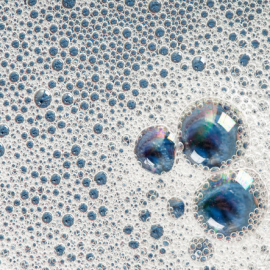With the rapid development of computer science and technology, the frequency of the computer central processing unit (CPU) has been greatly increased, the power and heat density of the CPU chip are increasing rapidly, and the heat dissipation problem is getting more and more attention, the CPU heatsink is the key component of the heat dissipation on the chip is quickly exported. So why use thermal silicone grease in the CPU?
Silicone grease plays an important role in the CPU, if used properly, it can make the heat sink perform better, not only the CPU temperature can be lower, but the fan speed can also be reduced a little bit, to get lower noise.
In computer hardware and electronic devices, heat dissipation has always been a concern. Thermally silicone grease ( also called silicone paste), as a common heat dissipation material, plays an important role in optimizing heat transfer and heat dissipation. Thermally silicone grease has a high coefficient of thermal conductivity, which can quickly transfer the thermal energy generated by the equipment, effectively reduce the temperature of the equipment, and improve the stability of equipment operation; thermally silicone grease can remain stable in a wide temperature range, is not easily affected by mechanical and chemical factors, and will not evaporate, evaporate, decompose, and the effect of long-term use is stable and reliable; thermally silicone grease can remain lubricated under special environments of high temperatures, high pressure, and enclosed spaces, and construction is easy. It also can be used as dielectric grease.
Here’s some information about it:
- What is thermal silicone grease?
- What are the advantages of thermal silicone grease?
- What is the role and principle of thermal grease?
- What is the principle of thermal silicone grease?
- How to pay attention when using silicone grease?
- How to apply thermal silicone grease in the CPU?
- How to choose thermal silicone grease?
- What are the key parameters for choosing thermal grease?
- How to make thermal silicone grease?
1. What is thermal silicone grease?
Thermally silicone grease is a silicone paste, a highly efficient heat dissipation product that fills in between electronic components and heat sinks. Its main function is to rapidly transfer heat generated inside high-temperature equipment to heat sinks or heat sinks and other heat dissipation media to maintain the normal operating temperature of the equipment. Silicone paste can fully wet the contact surface, thus forming a very low thermal resistance interface, heat dissipation efficiency is much superior to other types of thermal products, because of its high dielectric strength, it also can be used as dielectric grease and protective coating for lubricants fountain pen filling mechanisms, and threads, sealing and preserving O-rings.
Thermal silicone greases are usually made by the composite thermally conductive solid filler, base oil, such as silicone oil, and stabilizers and modified additives blended into a uniform paste material, commonly used thermally conductive silicone grease for the two colors of white and gray.
![]()
![]()
2. What are the advantages of thermal silicone grease?
(1) Strong insulation performance.
(2) Low thermal resistance, lasting paste state.
(3) Wide operating temperature range, stable performance in -45-200℃ environment.
(4) High thermal performance, cost-effective.
(5) Do not damage latex rubber and gaskets on dry suits.
3. What is the role of thermal silicone grease?
Thermally conductive silicone greases are a thermally conductive material commonly used to fill the tiny gaps between CPU, GPU, and other chips and heat sinks to improve heat transfer efficiency.
![]()
![]()
4. What is the principle of thermal silicone grease?
The main principle is to use the particles in the silicone oil based grease to fill the uneven part of the heat sink and chip surface to fill the tiny gaps, thus reducing the presence of the air layer and improving the heat conduction efficiency.
5. How to classify thermal silicone grease?
5.1 Silicone-based thermal grease:
Silicone-based thermal grease consists of silicone oil and fine thermally conductive fillers with high thermal conductivity and stability. Silicone oil-based grease is commonly used in high-performance computers and overclocking applications and can provide good heat dissipation.
5.2 Metal oxide silicone grease:
Metal oxide silicone grease is usually composed of silver oxide, aluminum oxide, or zinc oxide. It has high thermal conductivity and high-temperature resistance and is suitable for high-power applications and environments.
![]()
![]()
5.3 Carbon-based silicone grease:
Carbon-based silicone grease uses carbon nanotubes or graphene as a thermally conductive filler and has excellent thermal conductivity and electrical insulation properties. It is commonly used in high-performance electronic devices and LED cooling applications.
6. How to pay attention when using silicone grease?
If the CPU temperature is too high, it will lead to automatic shutdown or reboot of the computer, in the summertime is more serious, the outdoor and indoor temperatures are too high, and the CPU in operation at high temperatures will even reach seventy or eighty degrees, it is easy to be due to the poor heat dissipation and cause failures, and very likely to be the CPU's thermally conductive silicone grease appeared to be dry cracks or in the motherboard when the CPU and the heatsink contact appears. The CPU thermal grease has likely dried up or there is a gap between the CPU and the heat sink on the motherboard, which makes it difficult for the heat sink to play its proper role, thus preventing the heat from being transmitted.
(1) It should apply a thin layer of silicone grease evenly to completely cover the CPU surface.
(2) It should avoid over-tightening the heat sink screws to prevent extrusion of the silicone.
(3) It should Monitor CPU temperature and reapply grease as necessary (e.g., every 6-12 months).
(4) By considering these parameters and choosing the right grease, you can ensure optimal heat dissipation from the CPU and prevent overheating problems.
Thermally silicone grease is the medium of heat transfer, as long as the coating is evenly coated, coated thickness does not have much impact on the thermal performance, on the contrary, if you apply too much silicone grease coated with metal powder, the overflow of silicone grease may account for the surrounding components such as resistors, which may result in short-circuiting conditions, if it will be directly pierced by the motherboard or graphics card, so as long as coated uniformly on the good, not too much and not too little.
![]()
![]()
7. How to apply thermal silicone grease in the CPU?
(1) Surface cleaning
It should wipe the CPU surface clean to remove rust, dust, and oil.
(2) Apply the product
It should apply some thermal grease on the edge of the CPU.
(3) Apply evenly
It should spread the thermal grease with a spatula or brush.
(4) Thickness Control
It should spread the thermal grease evenly to the thickness of A4 paper.
In the process of reapplying thermal grease, it should be noted that only when the thermal grease makes the CPU and cooling fan stick together can the heat generated by the CPU be fully taken away. Therefore, it is important to apply the thermal grease evenly to avoid uneven application and air bubbles.
![]()
![]()
8. How to choose the silicone grease?
Selecting the most suitable silicone grease requires comprehensive consideration of the following factors:
(1) Thermal conductivity:
Thermal conductivity is an important indicator of the thermal conductivity of thermally conductive silicone grease, which indicates the ability to conduct heat per unit thickness. Higher thermal conductivity means faster heat transfer.
(2) Stability:
Thermally silicone grease should have good stability, able to maintain stable thermal conductivity in long-term use. Stability includes oxidation resistance and chemical stability.
(3) Ease of use:
The ease of use of thermally silicone grease is also one of the factors to consider. Some thermal silicone greases may require special handling steps or pre-treatment, while others are simpler to use.
(4) Cost-effectiveness:
The cost of thermally conductive silicone grease is also a factor to consider. High-performance thermally conductive silicone grease tends to be more expensive, so it needs to be considered in the context of specific needs and budgets.
For high-performance computers and overclocking applications, silicone-based thermally conductive silicone grease is usually the best choice. It has high thermal conductivity and stability and can provide good heat dissipation.
![]()
![]()
9. What are the key parameters for choosing thermal grease?
(1) Thermal conductivity (W/mK):
This indicates the ability of the grease to transfer heat from the CPU to the heat sink. Higher values (e.g. 4-8 W/mK) indicate better heat transfer, resulting in lower CPU temperatures.
(2) Viscosity (cP):
This measures the fluidity of the silicone grease. Thin (low cP) silicone grease is easy to apply but may not stay in place, while thick (high cP) silicone grease fills gaps better but requires more force to apply. Select the appropriate viscosity for the application (e.g., thin viscosity for tight gaps, thick viscosity for rough surfaces).
![]()
(3) Operating temperature range (°C):
Make sure that the silicone grease can handle the expected temperature range of your CPU. Exceeding the range may cause performance degradation or even decomposition of the grease.
(4) Conductivity (S/m):
Most CPU greases are non-conductive and protect against short circuits. Select conductive silicone grease only when the application requires it (e.g., some thermal pads).
This indicates the ability of silicone grease to resist electrical shock. Higher values are better for high-voltage applications.
![]()
![]()
(6) Chemical compatibility:
Ensuring the silicone grease is compatible with CPU and heat sink materials (e.g. copper, aluminum) to avoid corrosion.
(7) Anti-wear additives:
Some silicone greases contain additives that reduce friction and wear on the CPU and heat sink. Consider these for demanding applications.
(8) Application method:
Some silicone greases come with pre-applied pads or syringes for easy application. Choose the method that suits your comfort and skill level.
10. How to make thermal silicone grease?
Thermally silicone grease is a thermal paste, that secures electrical connections, it is mainly used in the manufacture of electrical appliances and electronics and can be used to exert heat dissipation performance so that the electrical appliances or electronics can have better heat dissipation performance and be safer to use. It can be used in computers, CPUs, power supplies, automotive electronics, sensors, and communication equipment, and some LED and integrated lights, TVs, radiators, storage drives and so on will be used. It is the lubricant of choice in food equipment, water fixtures, vacuum connections, ice machines, ovens, and refrigeration hardware. It also can be used as dielectric grease. How to improve the competitiveness of your products and make certain products suitable for the market?
XJY Silicones is one of the leading silicone MQ resin and VMQ silicone manufacturers in China, with more than 30 years of R&D and manufacturing experience in the silicone industry as well as more than 15 related patents and technical support. Our silicone raw material products can meet the needs of products in the electronic field and support the provision of diversified customized solutions.


